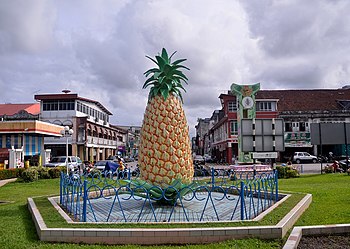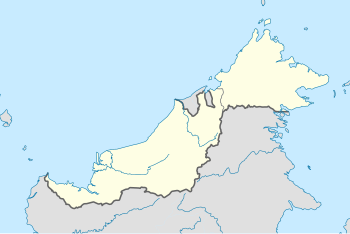Sarikei
| Sarikei 泗里街 |
|
|---|---|
 |
|
| Nickname(s): Pineapple Town/Swallow Town | |
| Location in Borneo | |
| Coordinates: 2°7′32″N 111°31′19″E / 2.12556°N 111.52194°ECoordinates: 2°7′32″N 111°31′19″E / 2.12556°N 111.52194°E | |
| Country |
|
| State |
|
| Government | |
| • Council Chairman | Cr. Chan Phan Chan |
| • Resident | Michael Dawi |
| Area | |
| • Total | 985 km2 (380 sq mi) |
| Population (2010) | |
| • Total | 56,798 |
| Time zone | MST (UTC+8) |
| • Summer (DST) | Not observed (UTC) |
| Postal code | 96xxx |
| National calling code | +6084 (local landline only) |
| License plate prefix | QR (for all vehicles except taxis) |
| Website | www |
Sarikei (Chinese: 泗里街; pinyin: sì lǐ jiē) is a town, and the capital of the Sarikei District (985 square kilometres) in Sarikei Division, Sarawak, Malaysia. It is located on the Rajang River, near where the river empties into the South China Sea. The district population (year 2010 census) was 56,798.
The most distinctive feature of the bustling waterfront is a 3.6 m high pineapple statue and also the tallest building in Sarikei - Wisma Jubli Mutiara.
The town itself consists of a main road, Repok Road which is bisected by another road leading to the new development in Kampung Seberang which is known as Susur Jambu.
The origin name of Sarikei was hard to be identified. Once upon a time, Sarikei was the centre for buying and selling chickens and hence it was called "Sa-rie-kei" ("Sa-rie" in most Chinese dialects means "centre" and "kei" means "Town"). Later the spelling was changed to Sarikei.
The early history of Sarikei can be traced as far back as the early 19th century. There are many historical events to show its existence. For example, Rajah James Brooke first visited Sarikei on 30 April 1845. There were also resistance from the local people towards the Brooke’s administration, including the burning of Sarikei on 4 January 1856 and the Julau Expedition on 19 June 1856, which was led by Sir Charles Brooke to counter the native resistance in Julau.
The establishment of Sarikei as a new Division was mainly based on security consideration. Datu Wilson Baya Dandot, The Deputy State Secretary (Planning and Development) in his article entitled: Sarawak’s Unique Administrative Identity: Establishment of Divisional, District and Sub-District Machinery For Enhancing Development Administration said that the establishment of Sarikei as the Sixth Division then was due to the security threats posed by the communist insurgency which was at its height at that time. It was felt that with the establishment of a new Sarikei Division the government would be able to concentrate and focus more in its efforts to contain and counter the security problem in the area.
Also known as the "food basket" for the Land of the Hornbills, Sarikei started as a small village comprising the "Segalang" community and a few rows of Chinese shophouses. From a dead town, the once isolated and remote Sarikei has progressed and the people now enjoy infrastructural facilities and economic opportunities.
...
Wikipedia

